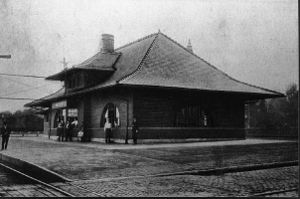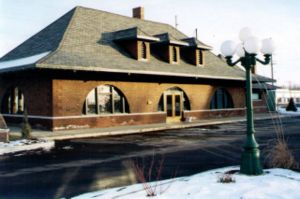Cloverleaf Depot and Railroad
Contents
Early Rail Travel
Railroads were the interstates of the late nineteenth and mid-twentieth centuries in Indiana, as well as the rest of the United States (Simons). Railroads, through growth and location within towns, would actually shape the city it beheld. Railroad tracks served for agriculture, industry, commerce, and recreation (Parker 1).
Narrow Gauge
In 1881 in Marion, IN, on Fourth and McClure streets, a railroad was built that would operate for many years to come. The railroad, starting in Toledo, OH, and running to St. Louis, MO, would eventually become considerable to surrounding Indiana cities. Built on narrow gauge rails in the 1870s and 1880s because of their inexpensive costs, the railroad was cheaply built with sharp curves (Simons). It would not be until June 26, 1887, between Frankfurt, IN and Toledo when 2000 men and boys would unite together to upturn 206 miles of narrow gauge to standard gauge. The conversion took eleven hours and its product of labor was rails now 4' 8.5 apart (Simons). In memory of this conversion, in 1992 a historic marker about the narrow-gauge movement was unveiled at the southeast corner of Fourth and McClure streets.
Standard Gauge
The new standard gauge rails had a battle to fight against the narrow-gauge rails because of cost. However, the standard gauge had history on its side as well as many benefits. To illustrate, the narrow-gauge width was also the size of the width between Roman chariot wheels and the trains on the early British railroad (Borowski). However, the narrow gauge rails did precede the standard as the founder intended. Wanting a narrow gauge empire, a pharmacist named Joseph Hunt began the railroad in Deiphus, Ohio. Starting in Delphus and continuing on to Toledo, Ohio, its destination moved westward. Hunt, however, was killed in a railroad accident, which resulted in some bankers and developers from Boston, Massachusetts to take over. Unfortunately, these men went bankrupt in the business only to be represented by Benjamin Harrison in their bankruptcy case with William Taft as judge.
Accidents
The railroad also had its share of bad luck, too. For instance, the Mississippi River in St. Louis flooded and washed out the track. Another example is when the bridge in Bluffton, IN burst and resulted in some fatalities. The most fascinating, however, might be in 1916 when a tornado picked up the acclaimed train, the Commercial Traveler, four miles east of Marion, IN and put it out in a surrounding field. The locomotive still remained on the track, the Pullman was upright, and the separate cars ended up scattered. Luckily, the accident ended with no fatalities but some maleficent injuries. That this is one of two accidents involving a tornado with a train to be recorded to this day (Simons). Railroads, though less common today than other modes of transportation today, were instrumental in the shaping of America’s transportation.
The Marion Depot
The contact point between the local community and the outside world came with the railroad depot (Parker 1). Writer Clay Lancaster portrayed a depot as:
The train station was the image of the community, presenting at a glance something about its size, affluence, livelihood, and social range of its citizens, their taste in architecture... The railroad depot is the foremost symbol of the evolving period of American civilization, of which there has been no replacement (Parker 1).
At the corner of Fourth and McClure Streets in Marion sits a depot once known as the Clover Leaf Depot because of the company that owned it. Known as the Clover Leaf Route, the company took its name from a three leaf clover, which was known as good luck when natural gas was discovered in the 1880s and 1890s.
Opening Day
At 9:30 A.M. on Wednesday, February 21, 1900, the Clover Leaf Train Station and Depot opened its doors opened to the public with the first train due to arrive at 10:32 A.M. At ten o’clock, the ticket windows were opened and the first ticket was sold by J.C. McLeod (New Station Opened 5). Divided into six sections, the station has two waiting rooms, two toilet rooms, a ticket office, and a baggage room.
Physical Description
Two rooms, the men’s room and women’s room, both have seats, and the ladies room is accommodated with rocking chairs. Both rooms have large, ornamental fireplaces and each toilet room has Tennessee marble. Gas and electricity are used for lighting purposes with electricity in preference because the depot has a complete electrical system, and the outside signals have electrical connections too. To heat the furnaces, gas is used by means of hot air furnaces. The dimensions of the waiting room are thirty-one feet by thirty feet, the baggage room twenty-three feet by twenty-four, and the office sixteen feet by sixteen. For further projects, the depot planned to build a little park that would include a fountain (The New Depot 5). However, the year 1900 was known as the apex of railroad dominance. Few railroads were built after 1900, and the Illinois Central and the Chesapeake and Ohio built the last major lines in Indiana early in the century. The national rail system reached its peak mileage, 254,000 miles, in 1916 (Parker 2).
The Famous Commercial Traveler
This depot was the home to one of the most recognized trains in the United States, the Commercial Traveler. The Commercial Traveler, running from Toledo to St. Louis, was equipped with a Pullman observation deck, a sleeping car with a drawing room with beds a porter would pull down, and a diner. The Commercial Traveler was put into service at the 1904 World’s Fair in Buffalo, New York(Simons). The railroad had a public contest to decide what the name of the train should end up, and the result was dubbed as the Commercial Traveler because many salesman went by train during the day to work. The vestibuled cars were equipped with Pintsch gas lighting instead of oil lamps, a new setting for its time. Since it was placed into service in January of 1901, the Traveler carried many passengers to the Pan-American Exposition in St. Louis and swiftly became a favorite of the traveling public. Regarded by railroad men as one of the finest trains in the Middle West, its popularity grew even more with the first electric headlights ever used in this part of the country (Grigg 3:17-19). In 1943, the Commercial Traveler was taken off the tracks first in Ohio with the regulatory permission from the Ohio Public Service Committee (Simons).
Conclusion
“Its days of glory are gone,” reads the headline of a newspaper article written in June of 1985. The year 1943 is now only a remembrance, as no one will any longer here the wail of a steam whistle on a locomotive trudging in to greet its future customers for the next ride. The station has not greeted a passenger train since 1943. After that, it was served by lines known as the Cloverleaf, the Nickel Plate, the Norfolk and Western, and finally, the Norfolk and Southern. When service degenerated in 1943, the depot was made into railroad offices until the early 1970s.By 1985, Marion real estate developer David Maidenberg was keeping an eye on the vacant and padlocked building. At that time Maidenberg wanted to renovate and convert the building to commercial office space, and he was waiting for a decision from the Norfolk and Southern ownership on whether or not it would sell this piece of living history(“Its days of glory are gone” Cl). Now, in 2001, the remembered depot has been remodeled and refurbished to create a Mexican restaurant labeled Mi Pueblo. Its “glory days” may be gone, but the recollection of its days past shall not be forgotten by the many generations of families, businessmen, operators, and dispatchers the railroad has served.
Works Cited
- Borowski, Greg J. “The wrong size of the tracks.” Chronicle Tribune 15 May 1992.
- “Its days of glory are gone.” Chronicle-Tribune 2 June 1985: Cl.
- Grigg, Steven L. Reflections: The Nickel Plate Years. 5 vols. The Nickel Plate Road Historical & Technical Society, Inc.
- “The New Depot.” Marion Daily Leader 21 Feb. 1900: 5.
- “New Station Opened.” Marion Daily Chronicle 21 Feb. 1900: 5.
- Parker, Francis H. Indiana Railroad Depots: A Threatened Heritage. 1989.
- Simons, Richard. Personal interview. 6 December 2001.
Credits
This article was written by Nancy Maidenberg and submitted on December 17, 2001 for Mr. Lakes' and Mr. Munn's classes at Marion High School.

